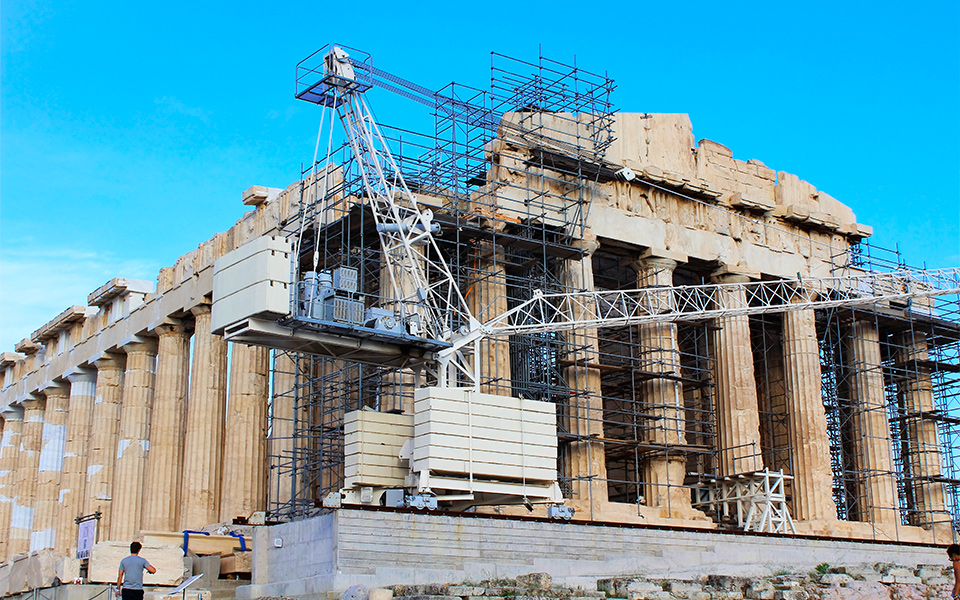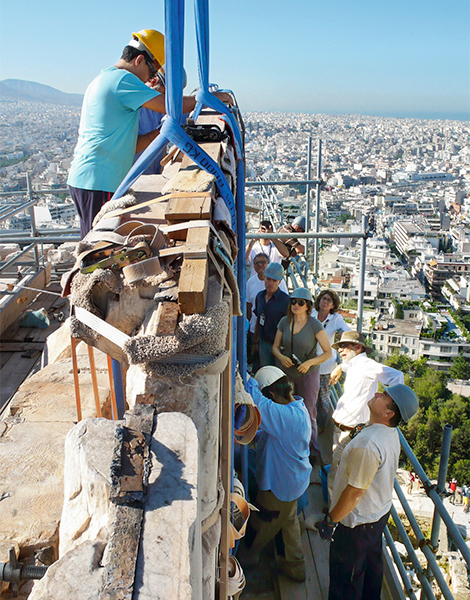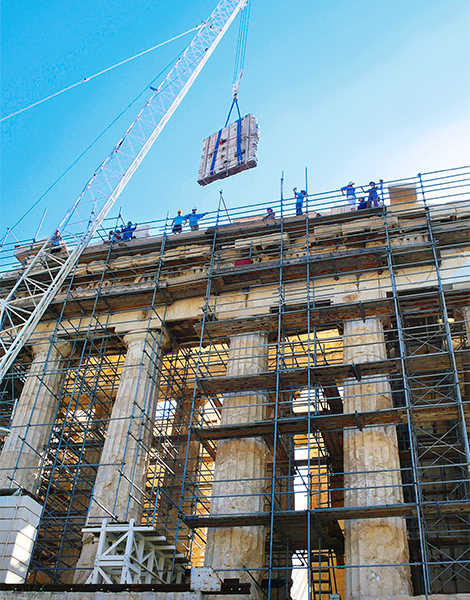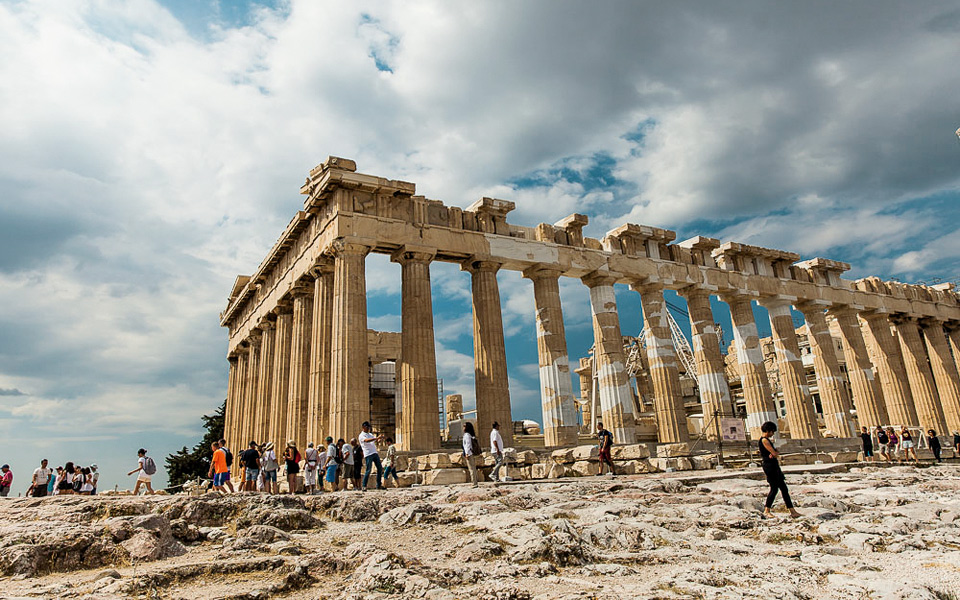Sacred Stones: Discovering Athens’ Byzantine Churches
Recycling is an age-old tradition in...

© Shutterstock
Architects, archaeologists, engineers, conservators, draughtsmen, marble masons and workers – the staff of the Acropolis Restoration Service (YSMA) – are the people we may see around us on every visit to the Acropolis, on scaffolding, on cranes, running the organized work areas. On a daily basis, they deal with the structural problems of these ancient monuments, dismantling ailing parts that need “healing,” conserving architectural members, completing them where necessary with new Pentelic marble, and repositioning them.
Nontheless, the lowering of every pedimental block or metope panel is for them a unique experience; of course, it’s even more amazing for those visitors who happen to be on the rock at the time of these delicate procedures. The crew’s preparation for the lowering of the central orthostate block of the Parthenon’s west pediment began at 7 am.
There was tension in the air and it seemed everyone’s adrenaline was pumping, but there was collaboration, and synchronization, too. First, iron fasteners holding the marble were cut, then modern cement had to be removed, wedges and lifting bands were put in place and, by one o’clock in the afternoon, the 7.5-ton orthostate had been lowered safely back to earth. The actual procedure of lowering it 10m took only ten minutes, but it had required months of preparation and meticulous coordination among the crew members.
The repair of the orthostate and other architectural members of the west pediment, damaged by the corrosion and the expansion of iron reinforcements installed by a previous restorer, Nikolaos Balanos, in the 1920s and ‘30s, as well as of five other stones from the pediment’s triangular central area (“tympanum”), is part of a new program of works recently begun on the Acropolis. It’s being funded under the European support package ESPA 2014-2020. The reconditioning of these 2,500-year-old architectural members will take two years and the work will be done on the spot.
Also planned are restoration works on the north wall of the Parthenon’s Cella, while activities such as the fluting of columns in the Pronaos (east porch) and the rehabilitation and repositioning of marble roof beams over the monument’s western colonnade will also continue. The budget for completing these latest interventions comes to €5 million.
The fundamental studies required for the new works were approved last year by Greece’s Central Archaeological Council, after the loss of the Acropolis Monuments Conservation Committee’s (ESMA) longtime president, Prof. Charalambos Bouras, who, before his death, had drafted the necessary documents for the planned interventions on the Parthenon’s west pediment.


The 7.5-ton central orthostate block of the Parthenon's west pediment is being lifted by a crane.
What do visitors see today on the Acropolis? “There are currently two work sites, one for the Parthenon and one for the walls of the Acropolis,” says Vasiliki Eleftheriou, director of YSMA.“For the Parthenon, we have three projects running, focusing on the west pediment, the north wall of the Parthenon’s Cella and the carving of flutes on a column of the Pronaos.
The project involving the walls, also approved and included in the formal program of works, has begun in the area north of the Propylaia (you can see it while walking through the Plaka district) and will continue north of the Erechtheion.” Work on the monuments often requires lengthy timetables. “The set-up of a site can take two or three months, as we follow all the necessary preparatory procedures, including things like tendering bids for the procurement of materials,” Eleftheriou continues. Tenders are also required for the removal of the old crane now standing in the middle of the Parthenon, to make way for the newer one, visible now on the temple’s west side. The whole procedure can take 3-4 months.
“When will we see the Parthenon without scaffolding…?” was a question that often concerned the late Bouras, and it’s also one that continues to engage ESMA’s current president, professor emeritus of architecture Manolis Korres. “Today, we’re seeing the Propylaia without the scaffolding it had,” says YSMA’s director Eleftheriou, taking the opportunity to emphasize the works that have already been finished and the significant changes that have been made.
“With the work completed there, we have handed back the monument and the whole double gateway is now clear of scaffolding. The Parthenon requires additional work, in part because one job often leads necessarily to another. I’d like to believe we will eventually see it without scaffolding, but this will involve a combination of factors: staff, time and procedures.” There are a few areas of the Parthenon that will remain at risk until the works on it are completed in 2020. “We have some loose ends to tie up,” Eleftheriou explains.

© Dimitris Vlaikos
“The walls of the Parthenon’s Cella will take us a few years, but the dangerous parts have already been removed. Repositioning of architectural members also takes time.” The lintel over the entrance in the Parthenon’s west wall still requires treatment, as it was previously restored by Balanos using concrete reinforced with low-grade iron. After the removal of these modern materials, the two original internal beams whose parts are preserved must be restored and supplemented with new marble. “It will be our next rescue operation,” notes Eleftheriou. “Everything is done in order of priority.”
Scientists aren’t just interested in restoring these monuments; they’re also concerned about what caused the damage in the first place. Seismic activity is being studied and monitored, but the greatest disasters appear to have been due to human actions. In the 1970s, the scientific community was greatly concerned with the effects of atmospheric pollution, but researchers have also been examining climatic changes and their consequences for a long time, and both issues remain relevant.
Regarding the effects of high temperatures, Eleftheriou states that: “we have yet to come to a consensus on monitoring methods, since the research is ongoing. YSMA is also collaborating with various programs at polytechnic schools, so we are still very much in the middle of things.”
Recycling is an age-old tradition in...
At the Athens English Comedy Club,...
From historic landmarks to edgy street...
A forgotten world comes to life...